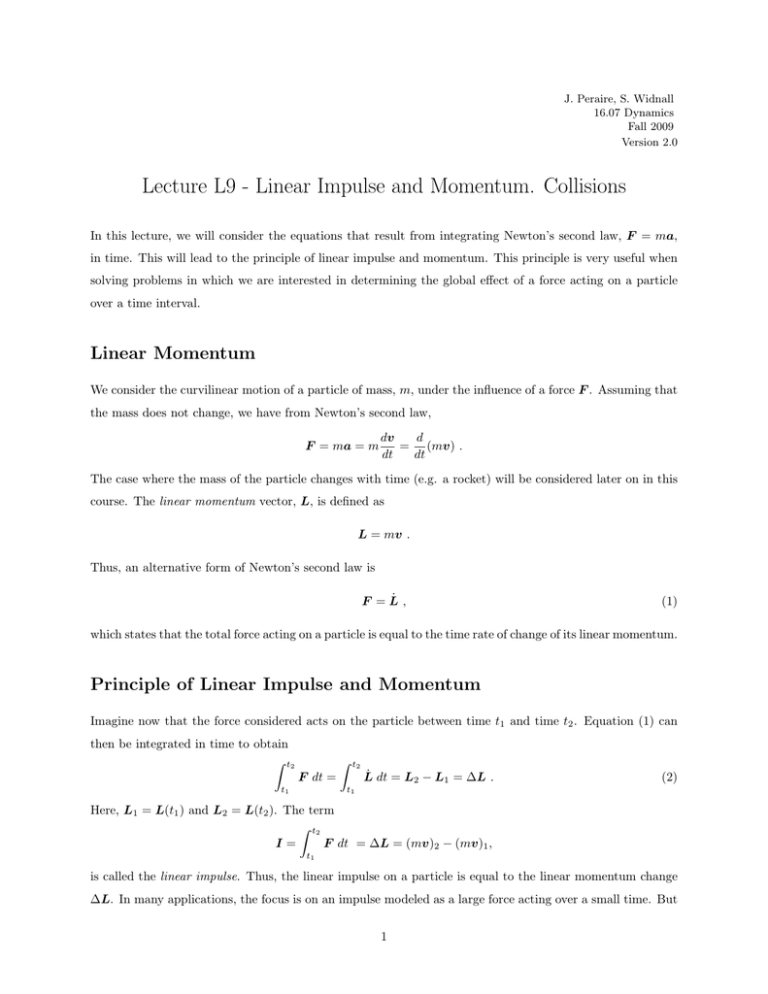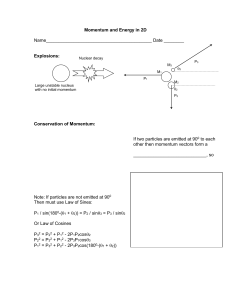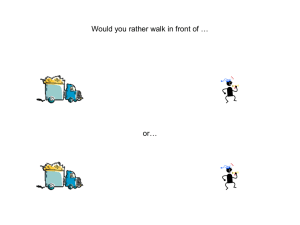Lecture L9 - Linear Impulse and Momentum. Collisions
advertisement

J. Peraire, S. Widnall 16.07 Dynamics Fall 2009 Version 2.0 Lecture L9 - Linear Impulse and Momentum. Collisions In this lecture, we will consider the equations that result from integrating Newton’s second law, F = ma, in time. This will lead to the principle of linear impulse and momentum. This principle is very useful when solving problems in which we are interested in determining the global effect of a force acting on a particle over a time interval. Linear Momentum We consider the curvilinear motion of a particle of mass, m, under the influence of a force F . Assuming that the mass does not change, we have from Newton’s second law, F = ma = m dv d = (mv) . dt dt The case where the mass of the particle changes with time (e.g. a rocket) will be considered later on in this course. The linear momentum vector, L, is defined as L = mv . Thus, an alternative form of Newton’s second law is F = L̇ , (1) which states that the total force acting on a particle is equal to the time rate of change of its linear momentum. Principle of Linear Impulse and Momentum Imagine now that the force considered acts on the particle between time t1 and time t2 . Equation (1) can then be integrated in time to obtain � t2 � t2 L̇ dt = L2 − L1 = ΔL . F dt = t1 (2) t1 Here, L1 = L(t1 ) and L2 = L(t2 ). The term � t2 I= F dt = ΔL = (mv)2 − (mv)1 , t1 is called the linear impulse. Thus, the linear impulse on a particle is equal to the linear momentum change ΔL. In many applications, the focus is on an impulse modeled as a large force acting over a small time. But 1 �t in fact, this restriction is unnecessary. All that is required is to be able to perform the integral t12 F dt. If �t the force is a constant F, then ΔL = t12 F dt = F (t2 − t1 ). If the force is given as a function of time, then �t ΔL = t12 F (t) dt Note Units of Impulse and Momentum It is obvious that linear impulse and momentum have the same units. In the SI system they are N · s or kg · m/s, whereas in the English system they are lb · s, or slug · ft/s. Example (MK) Average Drag Force The pilot of a 90, 000-lb airplane which is originally flying horizontally at a speed of 400 mph cuts off all engine power and enters a glide path as shown where β = 5o . After 120 s, the airspeed of the plane is 360 mph. We want to calculate the magnitude of the time-averaged drag force. Aligning the x-axis with the flight path, we can write the x component of equation (2) as follows � 120 (W sin β − D) dt = Lx (120) − Lx (0) . 0 The time-averaged value of the drag force, D̄, is ¯= 1 D 120 � 120 D dt . 0 Therefore, (W sin β − D̄)120 = m(vx (120) − vx (0)) . Substituting and applying the appropriate unit conversion factors we obtain, (90, 000 sin 5o − D̄)120 = 90, 000 5280 ¯ = 9, 210 lb . → D (360 − 400) 32.2 3600 2 Impulsive Forces We typically think of impulsive forces as being forces of very large magnitude that act over a very small interval of time, but cause a significant change in the momentum. Examples of impulsive forces are those generated when a ball is hit by a tennis racquet or a baseball bat, or when a steel ball bounces on a steel plate. The table below shows typical time intervals over which some of these impulses occur. Time interval Δt [s] Racquet hitting a tennis ball Bat hitting a baseball 0.005 – 0.05 0.01–0.02 Golf club hitting a golf ball Pile Driver 0.001 0.01 – 0.02 Shotgun 0.001 Steel ball bouncing on steel plate 0.0002 Example (MK) Baseball Bat A baseball is traveling with a horizontal velocity of 85 mph just before impact with the bat. Just after the impact, the velocity of the 5 18 oz. ball is 130 mph, at an angle of 35o above the horizontal. We want to determine the horizontal and vertical components of the average force exerted by the bat on the baseball during the 0.02 s impact. If we consider the time interval between the instant the baseball hits the bat, t1 , and the instant after it leaves the bat, t2 , the forces responsible for changing the baseball’s momentum are gravity and the contact forces exerted by the bat. We can use the x and y components of equation (2) to determine the average force of contact. First, consider the x component, � t2 mvx1 + Fx dt = mvx2 . t1 Inserting numbers and using appropriate conversion factors, we obtain − 5.125/16 5280 5.125/16 5280 (85 ) + F¯x (0.02) = (130 cos 35o ) → F¯x = 136.7 lb . 3600 32.2 3600 32.2 3 For the y direction, we have � t2 mvy1 + Fy dt = mvy2 , t1 which gives, 0 + F̄y (0.02) − 5.125 5.125/16 5280 (0.02) = (130 sin 35o ) → F̄y = 54.7 lb . 16 32.2 3600 We note that mgΔt = 0.0064 lb-s, whereas F̄y (Δt) = 1.094 lb - s. Thus, mgΔt is 0.59% of the total impulse. We could have safely neglected it. In this case we would have obtained F̄y = 54.4 lb. Conservation of Linear Momentum We see from equation (1) that if the resultant force on a particle is zero during an interval of time, then its linear momentum L must remain constant. Since equation (1) is a vector quantity, we can have situations in which only some components of the resultant force are zero. For instance, in Cartesian coordinates, if the resultant force has a non-zero component in the y direction only, then the x and z components of the linear momentum will be conserved since the force components in x and z are zero. Consider now two particles, m1 and m2 , which interact during an interval of time. Assume that interaction forces between them are the only unbalanced forces on the particles. Let F be the interaction force that particle m2 exerts on particle m1 . Then, according to Newton’s third law, the interaction force that particle m1 exerts on particle m2 will be −F . Using expression (2), we will have that ΔL1 = −ΔL2 , or ΔL = ΔL1 + ΔL2 = 0. That is, the changes of momentum of particles m1 and m2 are equal in magnitude and opposite in sign, and the total momentum change equals zero. Recall that this is true if the only unbalanced forces on the particles are the interaction forces. The more general situation in which external forces can be present will be considered in future lectures. We note that the above argument is also valid in a componentwise sense. That is, when two particles interact and there are no external unbalanced forces along a given direction, then the total momentum change along that direction must be zero. Example Ballistic Pendulum The ballistic pendulum is used to measure the velocity of a projectile by observing the maximum angle θmax to which the box of sand with the embedded projectile swings. Find an expression that relates the initial velocity of a projectile v0 of mass m to the maximum angle θmax reached by the pendulum. The mass of the sand box is M and the length of the pendulum is L. 4 We consider the equation of conservation of linear momentum along the horizontal direction. The initial momentum of the projectile is mv0 . Since the sand box is initially at rest its momentum is zero. Just after the projectile penetrates into the box, the velocity of the sand box and the projectile are the same. Therefore, if v1 is the velocity of the sand box (with the embedded projectile) just after impact, we have from conservation of momentum, mv0 = (M + m)v1 . After impact, the problem reduces to that of a simple pendulum. The only force doing any work is gravity and therefore we can apply the principle of conservation of work and energy. At the point when θ is maximum, the velocity will be zero. From energy conservation we finally obtain, 1 (M + m)v12 = (M + m)ghmax , 2 and since h = L(1 − cos θ), we have � θmax = cos −1 � 1− m M +m �2 v02 2Lg � . Note that energy is not conserved in the collision. The initial kinetic energy of the system is the kinetic energy of the projectile T0 = 1 2 2 mv0 (taking the reference height as zero). After the collision the kinetic energy of the system is T1 = 1 (m + M )v12 . 2 (3) T1 = 1 m2 v2 2 (M + m) 0 (4) m Since v1 = v0 (m+M ) we have which is less than T0 for M > 0. Collisions We consider now, the situation of two isolated particles colliding. The only forces on the particles are due to their mutual interaction. When the velocity vector of the two particles is parallel to the line joining the two particles, we say that we have one-dimensional collisions, otherwise we say that the collision is oblique. 5 1D Collisions Here, we are dealing with rectilinear motion and therefore the velocity vector becomes a scalar quantity. In order to understand the collision process we consider five different stages. I) Before Impact Let particle 1, of mass m1 , occupy position x1 and travel with velocity v1 along the direction parallel to the line joining the two particles. And let particle 2, of mass m2 , occupy position x2 and travel with speed v2 also in the same direction. We assume that v1 > v2 so that collision will occur. We can introduce the position of the center of mass xG = (m1 x1 + m2 x2 )/m, where m = m1 + m2 . The velocity of the center of mass is then given by vG = (m1 v1 + m2 v2 )/m. Note that since conservation of momentum requires (m1 v1 + m2 v2 ) = (m1 v1� + m2 v2� ), the velocity of the center of mass remains unchanged by the collision process between the particles. If we define the relative velocity g = v1 − v2 we can express v1 and v2 as a function of vG and g as, v1 v2 m2 g m m1 g. = vG − m = vG + II) Deformation The particles establish contact and the force between them Fd increases until the instant of maximum deformation. III) Maximum Deformation The contact force is at its maximum and the two particles travel at the same velocity vG . Thus the deformation force has slowed m1 down to a velocity of vG and sped up m2 to a velocity of vG . The impulse applied to particle 1 and 2 from the deformation force equals the change in momentum in the deformation process. 6 For particle 1 � − Fd dt = m1 vG − m1 v1 (deformation phase) and for particle 2 � Fd dt = m2 vG − m2 v2 (deformation phase) IV) Restoration The contact force Fr decreases and the particles move apart. The impulse applied to particle 1 and 2 from the restoring force equals the change in momentum in the restoration process. After the restoration process the velocity of m1 is v1� and the velocity of m2 is v2� . For particle 1 � − Fr dt = m1 v1� − m1 vG (restoration phase) and for particle 2 � Fr dt = m2 v2� − m2 vG V) After Impact The particles travel with a constant velocity v1� and v2� . 7 (restoration phase) From momentum conservation, the total momentum before and after impact should remain the same, i.e. m1 v1 +m2 v2 = m1 v1� +m2 v2� , and therefore the velocity of the center of mass will remain unchanged � = vG , thus mvG = m1 v1� + m2 v2� . If g � = v1� − v2� is the relative velocity of the two particles after vG impact, then v1� = v2� = m2 � g m m1 � vG − g . m vG + (5) (6) Coefficient of Restitution We define the coefficient of restitution as the ratio between the restoration and deformation impulses. � Fr dt e= � Fd dt For physically acceptable collisions 0 < e < 1. The value of e = 1 corresponds to an elastic collision, whereas the value of e = 0 corresponds to a totally inelastic collision in which the restoration impulse is equal to zero. We can consider each particle separately and set the impulse on the particle equal to the change of linear momentum Since for particle 1 � − Fd dt = m1 vG − m1 v1 (deformation phase) Fr dt = m1 v1� − m1 vG (restoration phase) � − Thus, e = (v1� − vG )/(vG − v1 ), or (e + 1)vG = v1� + ev1 . and for particle 2 � Fd dt = m2 vG − m2 v2 (deformation phase) Fr dt = m2 v2� − m2 vG (restoration phase) � Thus, e = (v2� − vG )/(vG − v2 ), or (e + 1)vG = v2� + ev2 . Combining the above expressions, we have � Fr dt =− e= � Fd dt v1� − v2� g� =− , v1 − v2 g which expresses the coefficient of restitution as the ratio of the relative velocities after and before the collision. Finally, if we know e we can use equations (5) and (6) to obtain 8 v1� = v2� = m2 eg m m1 vG + eg . m vG − Example Simple Collisions As an example, we consider a simple case of a mass m2 at rest and a mass of m1 traveling at velocity v1 headed for a collision with m2 . After the collision, the velocities of the two masses will in general be non-aero. We consider the cases e = 1, .5, and0, the is a range of coefficient of restitution between 1, perfectly elastic, to zero, perfectly inelastic. The result for the final velocities of m1 and m2 , normalized by the initial velocity v1 , are given by the equations above and shown in the figure. For e = 0, these is only one curve since the particles stick together: v1� /v1 = v2� /v1 . For the elastic collision, note the result for equal masses: v1� = 0 and v2� /v1 = 1 9 Energy We can now look at the kinetic energy before and after the impact. The kinetic energy before impact is, T = = = 1 1 m1 v12 + m2 v22 2 2 1 m2 m2 1 m1 m2 2 2 m1 (vG +2 gvG + 22 g 2 ) + m2 (vG −2 gvG + 12 g 2 ) 2 m m 2 m m 1 1 m1 m2 1 1 2 2 2 2 mv + (v1 − v2 ) = mvG + µg . 2 G 2 m 2 2 Here we introduce the notation µ = (m1 m2 )/m; this is often referred to as the reduced mass of the pair. The reduced mass approaches 1/2 of each mass when the two masses are similar, but it approaches the lighter mass if the masses are dissimilar. The kinetic energy after impact will be T� = = = since g � = eg and m1 m2 ) m 1 mv 2 + 2 G 1 mv 2 + 2 G 1 mv 2 + 2 G 1 m1 m2 � (v1 − v2� )2 2 m 1 m1 m2 �2 g 2 m 1 2 2 µe g . 2 = µ. Therefore, the kinetic energy lost during the collision is ΔE = T − T � = 1 µ(1 − e2 )g 2 , 2 which is zero for e = 1 (elastic collision), and maximum when e = 0. Momentum exchange We can also look at the momentum which is exchanged between particle 1 and particle 2, M12 = m1 v1 − m1 v1� = m1 (vG + m2 m2 g − vG + eg) = (1 + e)µg. m m This, is maximum when e = 1 (elastic collision) and minimum when e = 0. It is particularly illuminating to examine a special case of collisions, that for which the two masses are equal. We consider two cases shown in the figure. In both cases one particle is at rest, the other approaching with velocity v1 . In one case, we assume an elastic collision, e = 1; in the other a completely inelastic collision, 10 e = 0. In the first case, kinetic energy is conserved so it is obvious–although you can work out the algebra– that the first particle completely transfers its momentum to the second particle, where upon it continues to the right with the original velocity v2� = v1 . In the second case of a completely inelastic collision, there is no rebounding force and the particles stick and move together. Conservation of momentum requires the v2� = v1 /2. Kinetic energy is not conserved. Example Bouncing Ball If a ball, initially at rest, is released on a flat surface from a height h and it rebounds to a height h� , the coefficient of restitution is given by v� e=− = v � h� , h where v and v � are the velocities before and after impact. Oblique Collisions In the case of oblique collisions, we consider the instant of impact and define the normal direction, n, along the line that connects the two mass centers, and the tangential direction, t, along the line tangent to the surfaces at the point of contact. We write the equations of conservation of momentum in the tangent and normal directions. Since the force of contact is assumed to act along the normal direction, the conservation of linear momentum along the tangential direction implies m1 (v1 )t = m1 (v1� )t ⇒ (v1� )t = (v1 )t m2 (v2 )t = m2 (v2� )t ⇒ (v2� )t = (v2 )t In the normal direction, we solve a 1D collision problem, that is, m1 (v1� )n + m2 (v2� )n (v � )n − (v2� )n e = − 1 (v1 )n − (v2 )n m1 (v1 )n + m2 (v2 )n = which determine (v1� )n and (v2� )n . 11 ADDITIONAL READING J.L. Meriam and L.G. Kraige, Engineering Mechanics, DYNAMICS, 5th Edition 3/8, 3/9 12 MIT OpenCourseWare http://ocw.mit.edu 16.07 Dynamics Fall 2009 For information about citing these materials or our Terms of Use, visit: http://ocw.mit.edu/terms.








